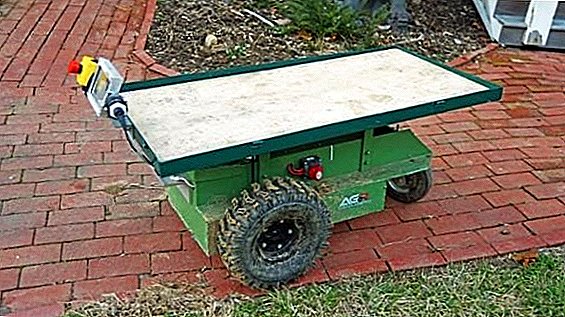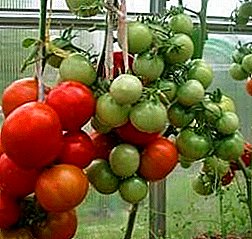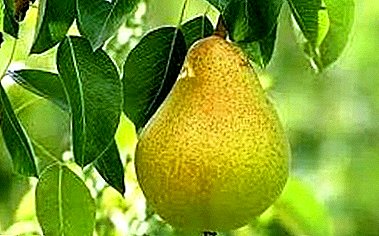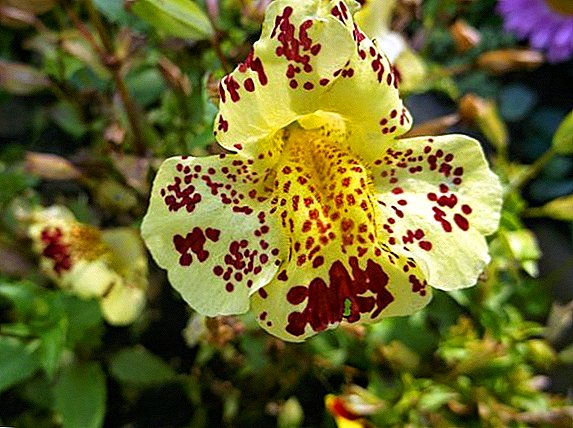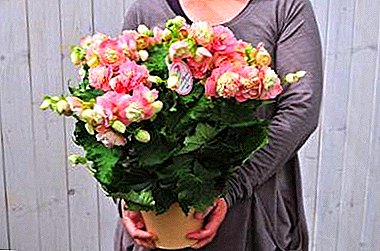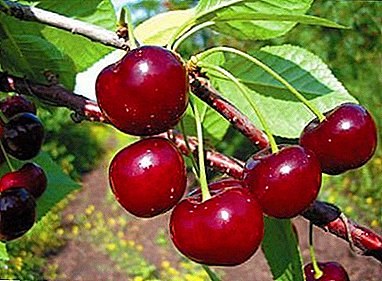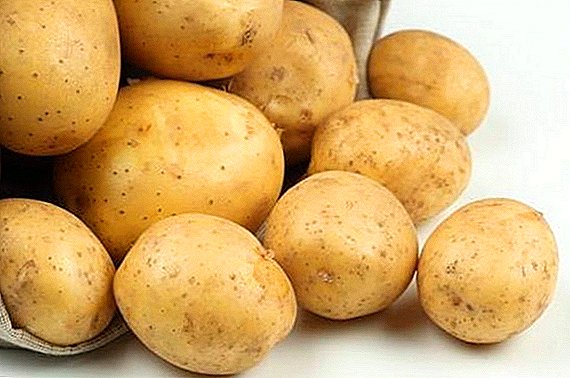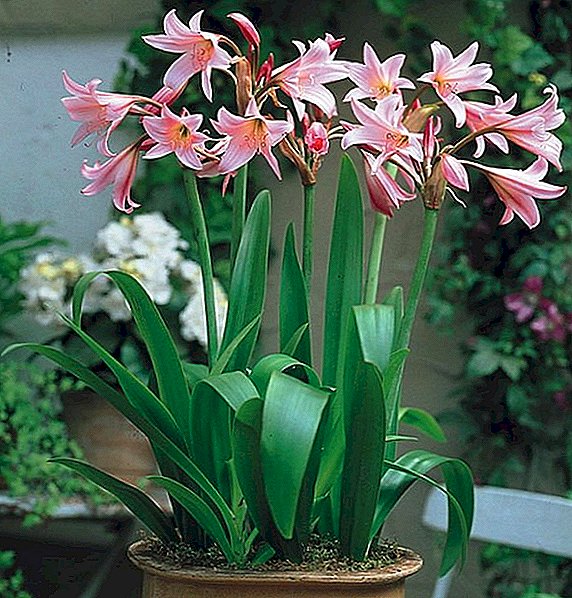 Quite often in the house or in the garden you can find a plant such as krinum or marsh lily. This is a very common and beautiful flower, it can grow in various conditions and decorate not only the window sill, but also the lawn near the house. Especially appreciated by landscape designers. A grower can grow as an experienced gardener, and novice amateur.
Quite often in the house or in the garden you can find a plant such as krinum or marsh lily. This is a very common and beautiful flower, it can grow in various conditions and decorate not only the window sill, but also the lawn near the house. Especially appreciated by landscape designers. A grower can grow as an experienced gardener, and novice amateur.
Botanical description
Crinum is a perennial plant of the Amaryllis family. It differs in that some of its varieties can reach gigantic sizes. Crinum has a large onion, which is 25 cm in diameter and has a short or long neck.
The leaves of the plant are usually large and perform the function of a false stem, which ends with a fluffy fan. They are linear-lanceolate and belt-shaped in shape, and are painted in a light green color. Reach in length can up to 1.5 m. Young foliage plants are usually rolled into tubes.
Distribution and habitat
Krinums love the warm and humid climate. There are many varieties of this plant that inhabit almost all corners of our planet. They are common in the mountains of South Africa, and in Asia and Australia. Tropical and subtropical latitudes are the ideal habitat for crinums. 
Popular types of crinuma
Crinum has a huge variety of species, each of which has its own peculiarities of cultivation and maintenance. Thanks to this, you can find a plant that is suitable for your weather and home conditions.
If your home is cold or you want to add beauty to the winter garden, such crunums as:
- Makovana In nature, found on the slopes of the mountains of Natal. In an umbrella-shaped inflorescence of about 15-20 flowers, a round bulb in diameter reaches 25 cm. It blooms in late autumn.
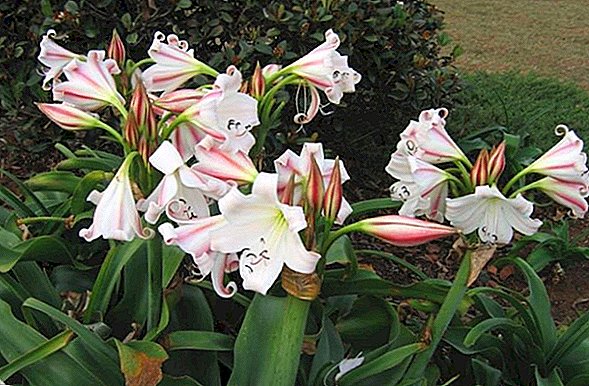
Did you know? In any pot will never hurt to put a pair of charcoal. This will saturate the soil with beneficial microelements.
- Broadleaf. It has a large number of large belt-like leaves, painted in bright green color. The inflorescences have the shape of an umbrella, the flowers are placed close to each other on short pedicels. The flowering period is at the end of August or the beginning of September.
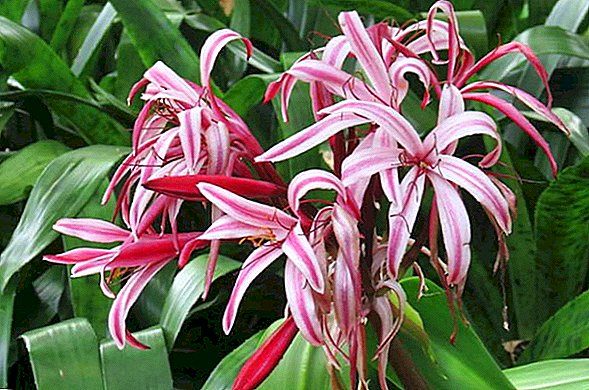
- Floriferous. Distributed in northern Australia. It has short light green leaves. Blooms in December with beautiful small inflorescences. The bulb is small with a short neck.
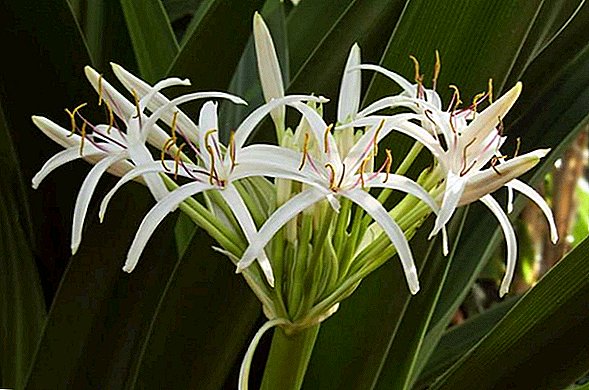
If you want to decorate a warm greenhouse, it is a great fit:
- Maiden or Verginsky krinum. The plant is originally from southern Brazil. Loves a warm and humid climate. It has a brown large onion. The leaves are rather narrow, sharp and long, with pronounced transverse veins. Umbrella inflorescence can include up to 6 flowers, located on very short pedicels. The flowering period is in autumn.
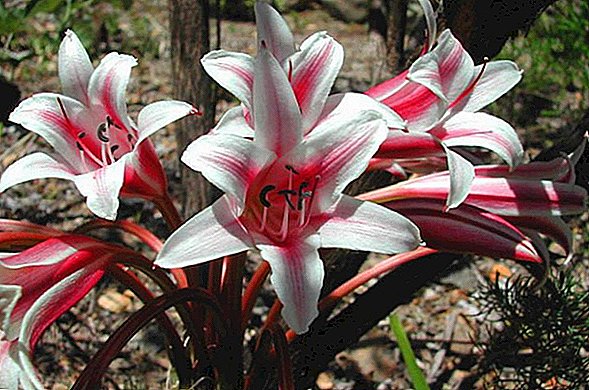
- Ceylon The plant is originally from Africa and Asia. It has an onion that reaches 25 cm in diameter, with a short neck. The inflorescence includes up to twenty colors and is located on a long and high stem that is colored bright green or red. There are not so many leaves, the quantity reaches 10 pieces. They are light green, long and belt-shaped.
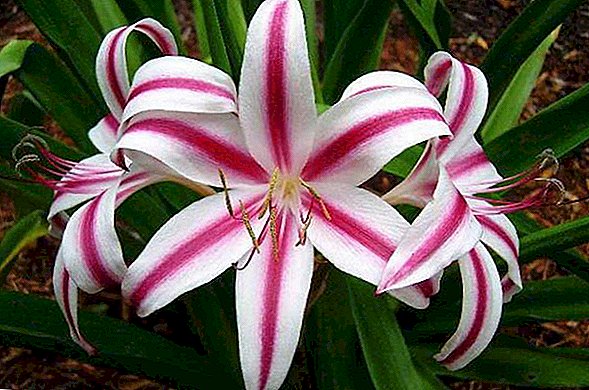
- Rough. Homeland is South Africa. Bulb large with a short neck. The leaves are long, distinguished by the fact that the base is often wavy. The inflorescence has the shape of an umbrella and holds from four to eight flowers. They fit snugly together and are located on short pedicels.
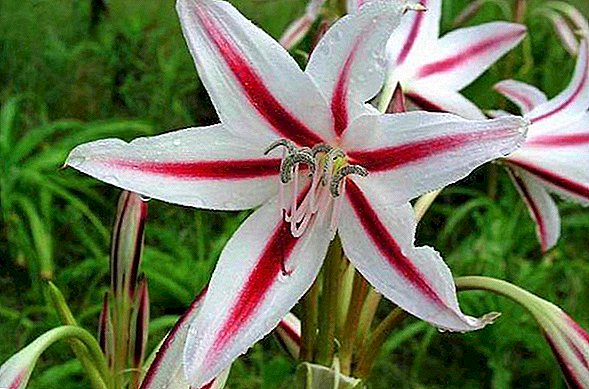
The bulbs also propagate such garden flowers as the autumn crocus, snowdrop, gladiolus, crocus, lily, hazel grouse, narcissus, tulip, licoris, Ixia, candyk, allium, zephyranthes, hionodoksa, sparaxis, tigridia and dahlia.
Krinum live even in the water. The perfect decoration of any pond or aquarium can be:
- Floating. Distributed in rivers and streams with a large current. The bulb reaches 5 cm in diameter. The stem of the plant is very short. The leaves are long, painted in dark green or brown, have a belt-like shape, often wavy or corrugated along the edges. The umbrella inflorescence usually settles down on a long leg, consists of a set of red or white florets.
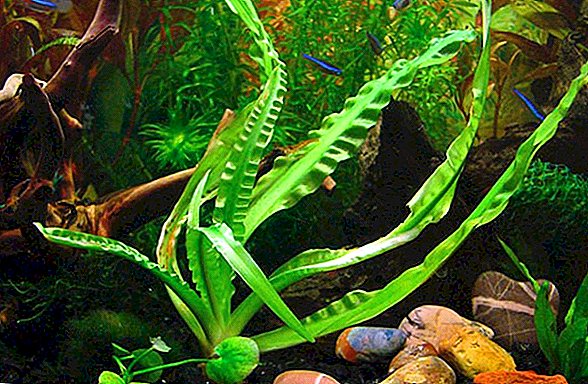
Did you know? The plant has very beautiful long leaves. Because of this, it got its name: "crinis" is translated from Latin as "hair".
- Purple. Favorite habitat are subtropics. The plant has a long stem that rises above the water. It contains inflorescences, petals are painted white. The leaves are hidden under water, reaching a length of 40 cm. The bulb is small, about 6 cm in diameter.
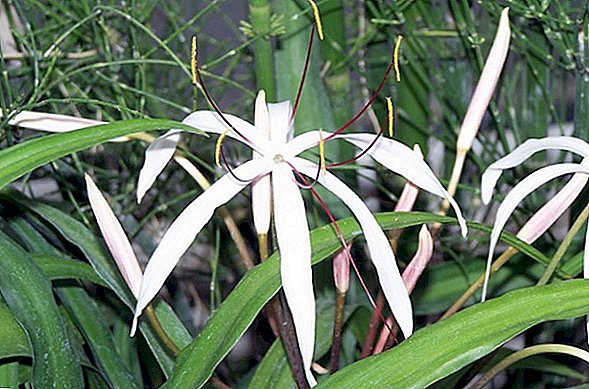
For growing outdoors, it must be borne in mind that the plant can tolerate changes in temperature and be resistant to the wind. For decorating the flower bed is perfect crinum Powell. The bulb of a plant has a form of a ball, reaches in the diameter of 15 cm.
The leaves reach a meter in length, belt-shaped, painted in a light green color. The inflorescence umbrella is located on a high stem. The flowers are quite large, reaching 20 cm in diameter, painted in light pink or white.
Favorite home flower, which gives the house comfort and beauty, is krinum Moore. He feels great in a dry home climate and does not need complex care. It has a large onion, reaching 20 cm in length.
The leaves are long, belt-like, sometimes wavy. The inflorescence is located on a high stem, forms the shape of an umbrella. May include up to ten flowers, the petals of which are painted pink.  This type of krinuma is most common for growing at home, greenhouses or greenhouses. It is most cultivated.
This type of krinuma is most common for growing at home, greenhouses or greenhouses. It is most cultivated.
Use in landscape design
Crinum is very beautiful and, at the same time, easy to care for the plant. Because of this, it is so valued in landscape design. Most often it is used for landscaping the coastal area.
If you want to decorate your plot, we advise you to read about how to make a ladybug, a dry stream, a waterfall, a mixborder, a fountain, a rosary, a rock garden, a flower garden made of wheel tires and a stone, and also how to properly arrange garden crops.
It gives a river or a lake neatness and beauty, looks sleeker than reeds or other river greens. Flowers krinum perfectly in harmony with the water surface, emphasize attention, give the reservoir a special mystery and irresistible.
This flower is also appreciated due to its endurance and durability. Transplantation and reproduction of plants are also quite simple, because of what it is so loved gardeners and landscape designers. 
Cultivation in the open field and at home
To ensure the correct conditions of krinum content, it is necessary to know some of its features, preferences, rules for transplantation and reproduction.
The plant itself is relatively unpretentious and hardy, but for its maximum beauty and health it is necessary to provide the right climate, lighting, moisture, acidity of the soil, fertilizing with fertilizers.
Conditions of detention
Crinum is a tropical plant that loves heat and moisture, as well as a large amount of light. Therefore, when choosing a place for his landing, it is necessary to make a start from this. It is necessary to protect the plant from the strong and cold wind.
Soil should choose sandy and make a little river sludge. At home, it is necessary to provide sufficient lighting. The amount of sun determines how big and beautiful the flowers will be, as well as the health of the plant.  It is best to choose a place where direct and warm sunlight will fall on the flower. The second feature of the maintenance of a marsh lily at home is to provide sufficient fresh air.
It is best to choose a place where direct and warm sunlight will fall on the flower. The second feature of the maintenance of a marsh lily at home is to provide sufficient fresh air.
To do this, you can put the plant near the window, so that in the process of ventilation it is enriched with the necessary amount of oxygen. Because of the large rhizomes, the krinum pot should be deep and wide. So the plant will feel as comfortable as possible, grow faster and delight rather big buds.
Important! When the content of the marsh lily on the windowsill is necessary to ensure that the leaves do not come into contact with the glass. Otherwise the flower may get burned.
Soil and fertilizer
Crinum loves sandy soil, which is mixed with river silt. It is quite nutritious and humid environment, which provides the swamp lily with all the necessary trace elements.  Therefore, when planting it on the site, it is recommended to prepare a mixture of sand, soil and river sludge. By planting a flower in a similar soil, you will provide him with comfort, and he will delight you with large and beautiful flowers.
Therefore, when planting it on the site, it is recommended to prepare a mixture of sand, soil and river sludge. By planting a flower in a similar soil, you will provide him with comfort, and he will delight you with large and beautiful flowers.
When growing krinuma at home, you must also create the right soil. To do this, use the soil mix. It consists of turf land, clay, peat, leaf soil, sand and humus. All this is mixed in a proportion of 2: 1: 1: 1: 1: 1.
You will probably be interested to learn more about different types of soil, fertilizer systems for them, as well as find out what basic properties of the soil, how to improve soil fertility.
Watering and moisture
In the open ground, the marsh lily needs to be watered daily, taking into account sunny and hot days. In cloudy and cool time, it must be watered once every two days. At home, you need to ensure that the earth never dried completely.
It should maintain moisture and water the plant in small doses daily. During the flowering period it is necessary to especially monitor the soil. It is enough to check if the top layer of the soil is dry.  If this happens, you should immediately water the plant. During the rest period, watering is recommended to be reduced, but not allowing the soil to dry completely, since the bulb is very sensitive and may die.
If this happens, you should immediately water the plant. During the rest period, watering is recommended to be reduced, but not allowing the soil to dry completely, since the bulb is very sensitive and may die.
Breeding
Krinem breeding occurs with the help of the onion-kids branch. Their appearance causes the plant to bloom. But it is not recommended to separate onions immediately. It is better to wait until they gain strength and grow a little. The size of the bulb depends on how quickly it blooms. This usually happens in the second or third year of life.
At home, the separated onions are planted in 12-centimeter pots. After a year, it is necessary to increase the diameter of the pots by at least 4 cm. Large pots should be used after four years of plant life.
They stimulate it to reproduction, providing maximum comfort. In the open ground, children should be separated during the rest period, namely: during the cold season.  But if you want the kids to get stronger and be ready to survive the winter on their own, it is better to separate them before the flowering of the mother bush. This is a bit risky, but most often the plant is calmly experiencing intervention.
But if you want the kids to get stronger and be ready to survive the winter on their own, it is better to separate them before the flowering of the mother bush. This is a bit risky, but most often the plant is calmly experiencing intervention.
Important! It is necessary to periodically feed the fertilizer with fertilizer. This is especially true for recently transplanted infant babies.
Transfer
Repot krinum at home is necessary every four years. The procedure should be carried out at the end of the rest period, that is, closer to spring. The bulb of a marsh lily needs to be placed in the earth so that its third was on a surface.
In the open ground, krinum can either be left to winter in the ground, or dig up. If you live in a mild and not very cold climate, it is better not to dig out the plant, so as not to injure it once more.
But in this case, you should completely bury the bulb in the ground. If the winters in your region are harsh, then plant a flower in the usual way, and in the winter dig it out and place it in a cellar or refrigerator.  Cinnamon grow in one place for four years, not more. After this period, the plants should be transplanted and be sure to separate the onion babies from them. Otherwise, the marsh lily will slowly fade.
Cinnamon grow in one place for four years, not more. After this period, the plants should be transplanted and be sure to separate the onion babies from them. Otherwise, the marsh lily will slowly fade.
Relation to temperature
At home, you need to determine the temperature according to where the plant comes from. If this is a tropical variety of crinums, then in winter the optimum temperature for them will be + 15-17 ° С. In the summer they will withstand any heat.
For plants that are accustomed to cold, it is necessary to provide a cool habitat with a temperature not higher than +25 ° C. Overwintering such a plant at a temperature of + 4-6 ° C without any damage.
In open ground marsh lily can be transplanted after the departure of frost. It is advisable to do this in April or May. In order for the crinum to calmly survive the winter, it is necessary to insulate the rhizome by laying up hay, peat, leaves. This will provide additional heat and safety of the bulb.  If your plant is still too small, it is best to dig it out for the winter and place it in the fridge in the department for vegetables and fruits. There is a suitable constant temperature regime that will make the plant addictive to cold and will not expose it to unnecessary threats.
If your plant is still too small, it is best to dig it out for the winter and place it in the fridge in the department for vegetables and fruits. There is a suitable constant temperature regime that will make the plant addictive to cold and will not expose it to unnecessary threats.
Possible difficulties in growing
Gardeners are rarely faced with difficulties in growing crinums. But with the wrong care some problems may arise. The most common is that the marsh lily is watered too often, leading to disease and wilt.
Or, on the contrary, water very rarely, damaging and draining the onion. Sometimes it happens that the owner did not notice the disease on time and did not begin to treat it. This often leads to the death of the plant.
The main difficulty in growing the crunes is to ensure the right temperature conditions for tropical and common varieties, optimal supply of sunlight.
The difficulty lies in the fact that swamp lilies from different latitudes get along badly under the same conditions. Therefore, you need to decide exactly what kind to keep at home to ensure maximum flower comfort. 
Pests, diseases and prevention
If you water the flower too often and there is a lot of moisture in the pot, your plant can get sick with anthracnose. The disease manifests itself in the form of brown spots and drips on the edges of the leaves.
To cure a marsh lily, you need to cut off defective leaves and process the flower "Fundazol". Dilute the product must be in proportion: 2 g per 1 liter of water. It will be correct to reduce the number of waterings and to air the room more often.
Also, your garden should be filled with paints such plants as dodecateon, sparaxis, canary intestines, tress, bluegrass, dye drow, blue cyanosis, agapanthus, penstemon, anemone, gravity, armeria, crested.
Another common disease of crinuma is "red burn" or stagon sporosis. The disease is easily treatable with the aforementioned remedy diluted in the same proportion. The most dangerous pest for the marsh lily is the amaryllis worm.
It adversely affects the plant, very quickly can lead to wilting. To get rid of the infection, it is necessary to treat the swamp lily with any insecticide.  Red burn on crimson Correct proportion: 2 ml per 1 liter of water. To prevent this worm from occurring, it is sometimes necessary to spray the krinum with the above solution.
Red burn on crimson Correct proportion: 2 ml per 1 liter of water. To prevent this worm from occurring, it is sometimes necessary to spray the krinum with the above solution.
Crinum or marsh lily has many varieties. Thanks to this, it will become both a wonderful decoration of your garden and a beautiful addition to your home interior. These flowers are very elegant and unpretentious. With minimal care and proper watering, they will live a long time, delighting you with beautiful leaves and inflorescences with a pleasant aroma.
Reviews from the network
Onion, I immediately landed on a flower bed. All summer she spent in the open field. I didn’t pay much attention to it, I watered it like the other flowers. What is her name and what conditions she needed did not know. Since the adult plant krinum is very large, it is more than 1 m high, and I did not think of where to place it, until the autumn I gave it to my friend. She lived with her for 3 years, never blossomed, the truth grew up (from a small diameter of 2-2.5 cm was about 5 cm) After 3 years she came back to me again. Again, because of the lack of space, I gave it to my sister. Some information was found, the care for her changed a little and after a couple of years (I can’t say more precisely, the diary did not keep) she blossomed for the first time. It was just a miracle. Delicate, fragrant flowers conquered all those who saw this miracle. The following year, and a couple more after it did not bloom, interest in it waned. In the spring she will return to me again, we will learn to bloom.













